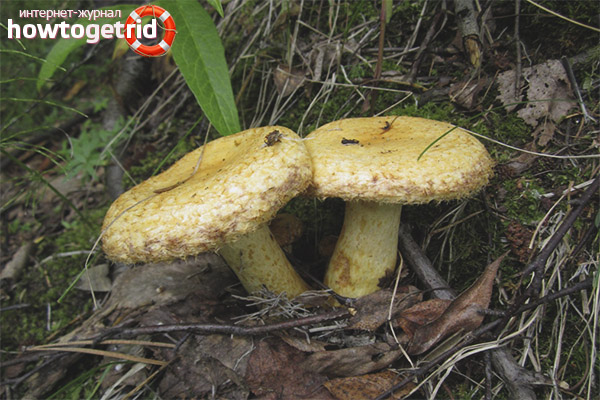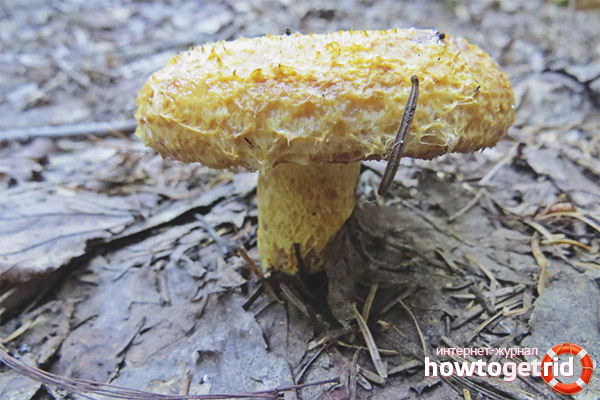The content of the article
The bluish breasts are also called canine. As for the growth and number of copies, these representatives of the family are quite difficult to meet. They prefer to live in clay soil, like dampness, as well as forest stripes with spruce or birch. Growth originates with the rest of the varieties.
Description
- The instance got its name due to the feature turning blue when the plates are pressed. They like to grow in colonies or in quiet solitude. This variety of fruiting bodies is very good in salting, the bitter taste is easy to remove by preliminary soaking.
- The top is convex in shape, the edges are bent inward. In grown specimens, the surface becomes like a funnel. That is, open with some depression in the center. In diameter, the upper part grows to 12 cm on average, but overgrowths also occur. The surface with scales, pigmented in yellow, may have whitish blotches. When it’s wet on the street, a slimy film forms.
- If you put pressure on the hat, it will change color to purple. The plates are located close to each other, they are narrow and fall to the base. They are painted yellow, but turn blue when pressed. A round-shaped base, thin at the beginning, grows up to 8 cm in height with a thickness of 3 cm.
- The surface of the legs is covered with small recesses of brown tone. When heat and dryness are replaced by coolness and humidity, the leg is covered with gummy mucus. The soft part is compacted, it does not crumble, it is bitter to the taste, the smell of mushrooms. Yellow caustic milky juice is released from it, after weathering it becomes bluish.
- This variety can be consumed if thorough pre-treatment is carried out. Mushrooms must be soaked in saline or ordinary cold water, then boiled and proceed with further manipulations (frying, stewing, pickling, etc.).
Edibility
- In countries with a rare amount of these mushrooms, specimens are not at all consumed as food. People try to avoid them, because they are practically not aware of the rules of cooking and edibility in particular. And those who know how to cook do not want to bother with the preparation.
- According to its taste characteristics, this representative of the family is inferior to brothers. It is conditionally edible, which means that some of the taste is lost when soaking and cooking. However, dog breasts are richer than similar species of the family when it comes to pickling or pickling. In the latter case, not everyone will like the color of pickled mushrooms.
- As mentioned earlier, this species is allowed to eat by soaking and digesting. Bitterness will disappear from such actions. To prepare a delicious dish, culinary experts advise frying fruiting bodies. Also exclusively young specimens are suitable for consumption in food.
Growth
- Discussed fruiting bodies prefer to build mycorrhiza with birch, willow, and spruce. They settle in forests of mixed or coniferous type. Try to choose moist soil and moist places in particular.
- Growth is carried out in splendid isolation or in small groups. Begin to bear fruit in August, this continues until the end of autumn.
- When considering the distribution area, it makes sense to highlight specific areas. You will find blue mushrooms in North America, Greenland, Eurasia, and Taimyr.
Similar varieties
- Oak Breast. The species under discussion is similar to oak mushroom, which is also attributed to conditionally edible specimens. It is used salted. The hat grows to 10-12 cm.in diameter, painted in brick or orange. The shape is first rounded, then becomes like a funnel. The soft part is whitish or yellow-beige. Turns pink when broken. The leg extends up to 7 cm. With a thickness of 3 cm. Maximum. Fruiting begins in mid-summer, ends with the beginning of autumn.
- Black lump. Another variety related to conditionally edible mushrooms. Most often consumed after salting. Otherwise, the fruiting bodies are called gypsies, blacks, black hollows. The large top grows up to 20 cm in diameter. The hat is flattened, there is a depression in the center. When damp, the surface is covered with mucus. The soft part is compacted and light, when broken, it turns gray. The base is elongated up to 7 cm. With a thickness of 2 cm.
This material is dedicated to the representative of the family, which refers to conditionally edible mushrooms. It is allowed to consume the product only after pre-soaking and digestion.











Submit